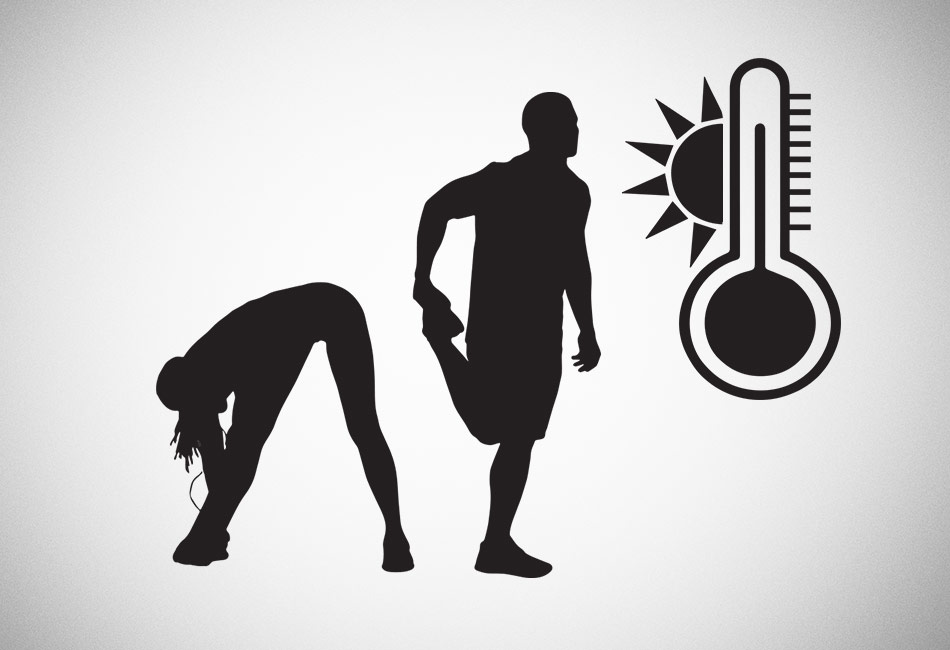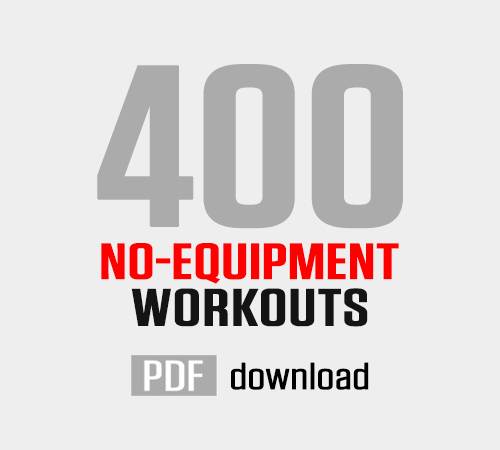Summer heat provides the perfect way to level up with less effort. But you need to be smart, methodical and consistent in your efforts. To understand how to better use summer weather to improve fitness we need to examine some of the basic mechanisms at work when exercising in hot weather.
Heat Transfer
First of all it’s heat. Whenever we exercise our muscles use up fuel in the form of ATP and oxygen and generate heat alongside other byproducts. Our body’s core temperature is, usually, 37℃ (98.6℉). While there is a margin of safety in that, it is a pretty small one. So when our core temperature increases our body sweats to help us cool down.
Sweat however is not the only cooling mechanism we have. We also breathe harder to expel hot air and breathe in cooler air. This adds an extra load to our lungs. In addition capillaries near the skin dilate. This causes them to fill up with more blood and plasma than usual; allowing the skin to radiate heat away from the body.
The extra heat our bodies generate naturally, when we train is called “thermal load”. This increases when we train in hot weather and it becomes a significant variable that triggers a number of adaptation responses. Because of the additional pressures it applies to our physiological processes it is often called “heat stress” and it this that actually helps us get fitter by pushing the cooling mechanisms our bodies employ to the limit.
Benefits of Working Out in a Hot Environment
If you’re a runner we have a complete guide to the benefits of running in hot weather. But if you’re more into workouts then this is what happens when you push your body’s cooling mechanism to the limit:
Sweat – By training in the heat we sensitize the body’s perspiration mechanism. Heat-stress trained bodies, perspire earlier and perspire more [1] which means they maintain their core temperature at an even level and can function when everyone else is experiencing overheating that leads to muscles losing as much as 50% of their efficiency and tiring at least twice as fast. [2]
Lactate Threshold – When the levels of lactate (i.e. acid) byproducts in the bloodstream begin to increase the efficiency of muscles drops and they tire much faster. Training in the heat helps the body acclimate to heat stress and produces a greater window of physical activity before lactate byproducts in the bloodstream begin to accumulate. [3]
Plasma – The bloodstream consists of fluids (plasma) and oxygen-carrying red blood cells. When the body overheats skin vessels dilate and increased volume of blood rushes to the skin surface to cool it down. This diverts blood (and its oxygen) from the heart and muscles that need to work harder. Studies have shown that training in hot weather results in increases in blood volume with higher plasma content. This allows the body to use fluid to cool down the skin and divert oxygen-carrying blood to the muscles, ensuring that they can continue to work efficiently despite the thermal load being experienced. What’s more, this positive adaptation in blood volume is experienced regardless of age or gender. [4, 5]
Aerobic capacity – A study involving competition cyclists who were split into groups training in hot and cold environments showed that those who were subjected to training in a hot environment experienced an 8% gain in VO2 max. [6]
Salt retention – Sodium chloride (salt) in the body helps with muscle contractions, fluid balance and nerve conduction. This means that when its concentration drops because of excessive sweating, muscle cramps, poor coordination and muscle fatigue quickly follow. During excessive sweating Potassium and sodium chloride are lost at a very fast rate which can lead to muscular weakness, muscle cramps, loss of concentration and poor motor-neuron control. [7, 8] Studies have shown that prolonged heat stress causes adaptations that increase the production of a hormone called aldosterone. [9] This regulates the loss of potassium and sodium chloride through sweat and maintains the body’s capacity to function at a high rate despite the hot weather.
These benefits happen irrespective of the levels of humidity experienced and whether the environment is dry (hot weather in open air with relative low humidity levels) or wet (training in a sauna or by a heated pool where humidity levels are high). [10, 11]
The Dehydration Response
In addition, further studies [12] have shown that the benefits of working out in hot weather can be accelerated if a certain level of dehydration is added to the process by, for instance, not taking any fluids during the exercise period. Coaches suggest this creates even more aerobic and cardiovascular efficient athletes but needs to be monitored closely in order to avoid any adverse effects from overheating.
How to Prepare for Training in a Hot Environment
If you’re ready to add heat-stress to the means you use to get fitter and feel stronger then the best way to approach it through a structured plan.
- Pick what you will do: A. Workout by a heated pool, B. Workout in the sun or a hot room, C. Grab a sauna or a very hot bath immediately after a heavy workout (all of these add heat-stress and deliver the fitness benefits we have already iterated).
- Have enough water at hand: Even if you decide to add dehydration to your fitness routine by not drinking any water during the full period you exercise, it is wise to have water available. You should have at least one liter of water for each hour you exercise in a hot environment [13].
- Keep an eye on intensity levels: Heat is an additional level of difficulty. Until you become acclimated your intensity level should drop to avoid overheating and the loss of salts that will lead to rapid fatigue and muscle cramps.
- Use dehydration with care: If you do decide to make your training in a hot environment harder by not drinking any water during the period you exercise, make sure that you at least drink plenty of water immediately after and that this is not your first time training in a hot environment.
- Take things slow: Heat-stress adaptations take time and becoming acclimated to hot environment workouts requires patience. Start slowly, start small; be patient and gradually build up. [14] This is particularly important if you also decide to use dehydration as an additional physical stressor.
- Aim to sweat: There is little point to training in a hot environment if you do not seek to trigger the sweat response as quickly as possible and then maintain it for some time. If you’re training outside, in the sun, you’re going to sweat anyway, but if you’re training indoors in an artificially warm environment you should consider adding an extra layer of clothing.
Summary
Working out in a hot environment delivers significant fitness benefits by triggering biological adaptations that benefit overall performance. These adaptations stay with us even when we stop training in a hot environment, though it is unclear if subsequently; over time they fade or simply become dormant. One unexpected side effect of training in a hot environment is central nervous system (CNS) fatigue which impairs our ability to think clearly. [15] It also affects motivation and coordination. Provided a little care is taken and we proceed in small steps each time so that we can get acclimated properly, working out in a hot environment should be added to the techniques used to help improve overall fitness, faster.
Sources
1. Armstrong, Lawrence & W. Hubbard, Roger & H. Jones, Bruce & T. Daniels, Jack. (1985). Preparing Alberto Salazar for the Heat of the 1984 Olympic Marathon. Phys Sports med. 3. 24. 10.1080/00913847.1986.11709011.
2. Limits to Exercise Performance in the Heat. M. Hargreaves, M. Febbraio School of Human Movement, Deakin University, Burwood, and Department of Physiology, The University of Melbourne, Parkville, Australia.
3. Lorenzo S, Minson CT, Babb TG, Halliwill JR. Lactate threshold predicting time-trial performance: impact of heat and acclimation. J Appl Physiol (1985). 2011;111(1):221–227. doi:10.1152/japplphysiol.00334.2011
4. Institute of Medicine (US) Committee on Military Nutrition Research; Marriott BM, editor. Fluid Replacement and Heat Stress. Washington (DC): National Academies Press (US); 1994. 16, Changes in Plasma Volume During Heat Exposure in Young and Older Men.
5. J Appl Physiol Respir Environ Exerc Physiol. 1979 Nov;47(5):978-84. Effect of training and heat acclimation on exercise responses of sedentary females. Fortney SM, Senay LC Jr.
6. Lorenzo S, Halliwill JR, Sawka MN, Minson CT. Heat acclimation improves exercise performance. J Appl Physiol (1985). 2010;109(4):1140–1147. doi:10.1152/japplphysiol.00495.2010
7. Institute of Medicine (US) Committee on Military Nutrition Research; Marriott BM, editor. Fluid Replacement and Heat Stress. Washington (DC): National Academies Press (US); 1994. 10, Potassium Deficiency as the Result of Training in Hot Weather.
8. Bates GP, Miller VS. Sweat rate and sodium loss during work in the heat. J Occup Med Toxicol. 2008;3:4. Published 2008 Jan 29. doi:10.1186/1745-6673-3-4
9. Montain, Scott & E. LAIRD, JANET & A. LATZKA, WILLIAM & Sawka, Michael. (1997). Aldosterone and vasopressin responses in the heat: Hydration level and exercise intensity effects. Medicine and science in sports and exercise. 29. 661-8. 10.1097/00005768-199705000-00012.
10. Garrett AT, Creasy R, Rehrer NJ, Patterson MJ, Cotter JD. Effectiveness of short-term heat acclimation for highly trained athletes. Eur J Appl Physiol. 2012 May;112(5):1827-37. doi: 10.1007/s00421-011-2153-3. Epub 2011 Sep 14. PubMed PMID: 21915701.
11. J Sci Med Sport. 2007 Aug;10(4):259-62. Epub 2006 Jul 31. Effect of post-exercise sauna bathing on the endurance performance of competitive male runners. Scoon GS1, Hopkins WG, Mayhew S, Cotter JD.
12. Trangmar SJ, Chiesa ST, Stock CG, Kalsi KK, Secher NH, González-Alonso J. Dehydration affects cerebral blood flow but not its metabolic rate for oxygen during maximal exercise in trained humans. J Physiol. 2014 Jul 15;592(14):3143-60. doi: 10.1113/jphysiol.2014.272104. Epub 2014 May 16. PubMed PMID: 24835170; PubMed Central PMCID: PMC4214665.
13. Montain, Scott & A. Latzka, William & Sawka, Michael. (1999). Fluid Replacement Recommendations for Training in Hot Weather. Military medicine. 164. 502-8. 10.1093/milmed/164.7.502.
14. Akerman AP, Tipton M, Minson CT, Cotter JD. Heat stress and dehydration in adapting for performance: Good, bad, both, or neither?. Temperature (Austin). 2016;3(3):412–436. Published 2016 Jul 27. doi:10.1080/23328940.2016.1216255
15. Nybo L. CNS fatigue provoked by prolonged exercise in the heat. Front Biosci (Elite Ed). 2010 Jan 1;2:779-92. Review. PubMed PMID: 20036922.










